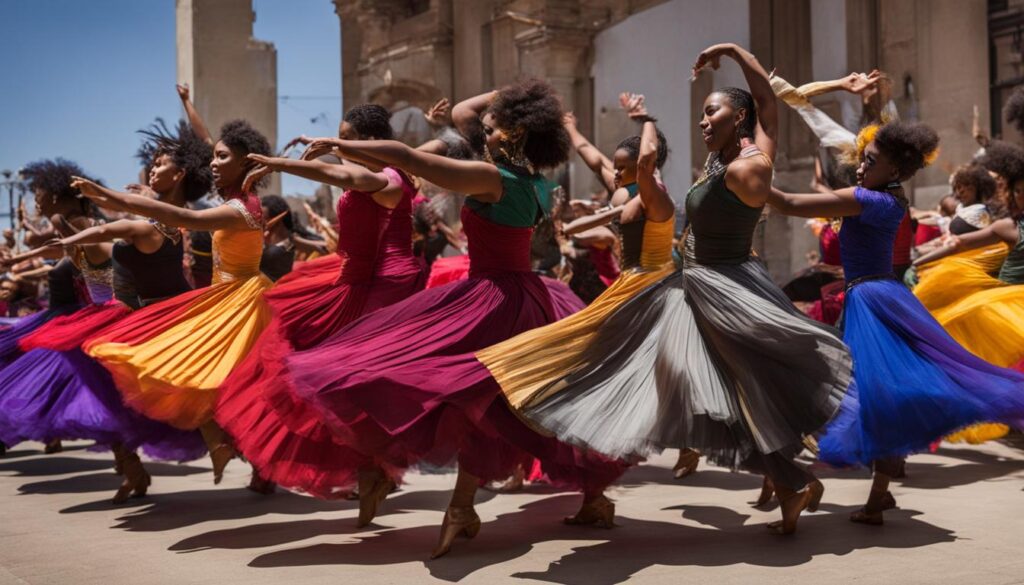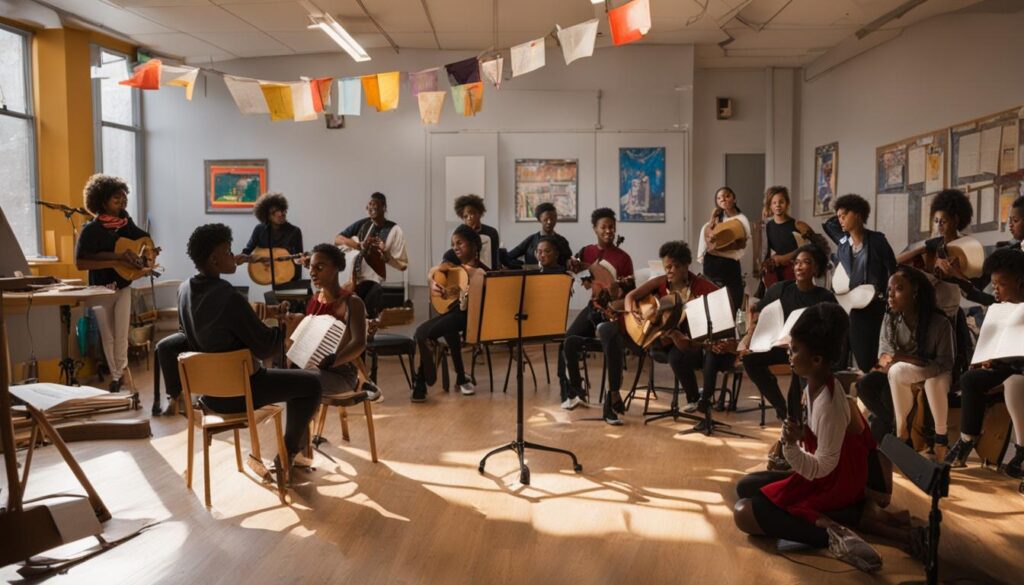Greetings! I’m here to take you on an exciting journey into the wonderful world of performing arts. From music and dance to theatre and beyond, performing arts encompass a range of artistic disciplines and forms of expression that captivate and inspire audiences.
When we talk about performing arts, we’re referring to the various concepts, elements, disciplines, genres, forms, techniques, components, and skills that come together to create these awe-inspiring performances. It’s a world filled with creativity, passion, and the power to move us emotionally.
Key Takeaways
- Performing arts encompass a wide range of artistic disciplines and forms of expression.
- Music, dance, and theatre are essential components of performing arts.
- Performing arts play significant roles in reflecting human creativity and preserving cultural heritage.
- Engaging in performing arts education offers numerous benefits for personal growth and holistic development.
- Safeguarding and promoting performing arts traditions is crucial for preserving cultural diversity and artistic expression.
The Importance of Music in Performing Arts
Music plays a pivotal role in the world of performing arts. It holds a central place in almost all forms of artistic expression, accompanying various disciplines and cultural traditions. The significance of music in performing arts goes beyond mere entertainment; it has the power to convey emotions, tell stories, and celebrate important events. Whether it’s a symphony orchestra in a concert hall or a folk dance accompanied by traditional music, the integration of music enhances the overall experience and adds depth to the performance.
Moreover, music in performing arts serves a political and economic dimension. It can reflect a community’s history, pay tribute to influential individuals, and even play a role in economic transactions through ticket sales and royalties. As a universal form of expression, music transcends cultural boundaries and fosters cultural exchange and creativity. However, there is a delicate balance to strike, as the popularity of certain music genres and styles can lead to the homogenization and commodification of diverse musical practices.
Safeguarding the traditions and techniques of music in performing arts is crucial to preserving cultural diversity and promoting the value of artistic expression. By recognizing the importance of music and its role in performing arts, we can ensure the continued development and appreciation of these vibrant art forms for generations to come.
“Music is the universal language of mankind.” – Henry Wadsworth Longfellow
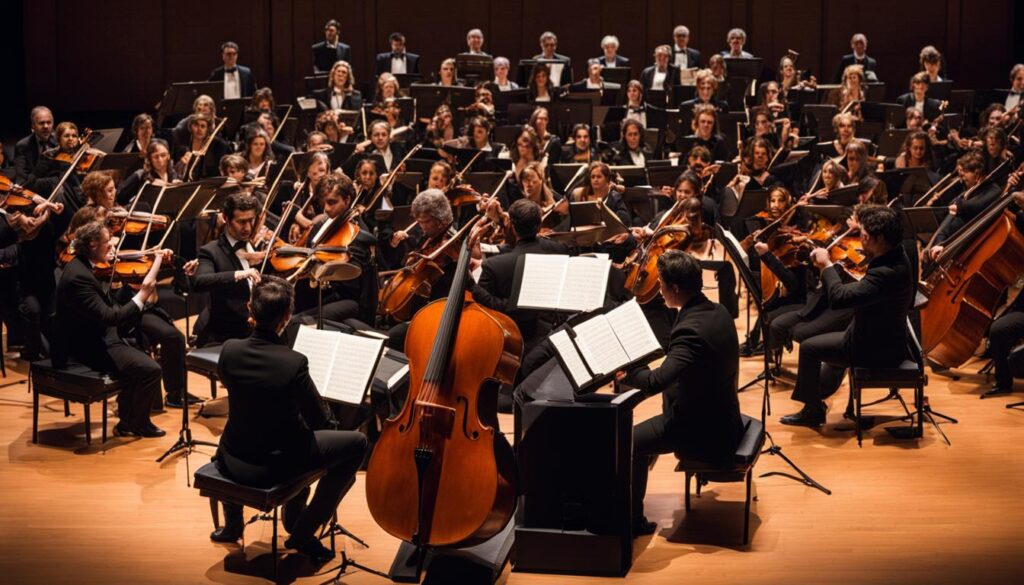

Table: Evolution of Music in Performing Arts
| Period | Key Developments |
|---|---|
| Ancient Times | Music played a vital role in religious and ceremonial practices. |
| Classical Era | The rise of opera and symphony orchestras revolutionized the integration of music in theatrical performances. |
| Modern Era | Exploration of new musical genres and the incorporation of technology in music production. |
| Contemporary Times | Advent of multimedia performances and the fusion of various music styles in the performing arts. |
Music has the power to transcend language barriers and evoke emotions that words alone cannot express. It is an integral element of performing arts that enriches our lives and connects us to diverse cultures and traditions. By recognizing and cherishing the importance of music in performing arts, we can preserve cultural heritage, promote creativity, and celebrate the universal language of mankind.
The Art of Dance in Performing Arts
Dance is a captivating and captivating form of artistic expression that holds a significant place in the world of performing arts. It is a vibrant and dynamic art form that involves ordered bodily movements performed to music, conveying emotions, stories, and abstract concepts. Dance is an integral part of various cultural and social contexts, often used in religious ceremonies, rituals, storytelling, and entertainment.
The role of dance in performing arts is multifaceted. It adds visual beauty, storytelling elements, and dynamic energy to performances, captivating audiences and creating a truly immersive experience. Through the coordination of movement and rhythm, dance has the power to communicate sentiments, moods, and specific events or activities. It serves as a powerful medium for self-expression and cultural identity, allowing individuals to embody and convey their emotions and experiences.
Safeguarding dance traditions and techniques is of utmost importance in preserving cultural heritage and promoting the diversity of performing arts. By preserving and passing down these artistic practices, we ensure that future generations can continue to experience and appreciate the richness and beauty of dance in all its forms.
The Significance of Dance in Performing Arts
Dance plays a crucial role in the performing arts, offering a unique and powerful means of communication and artistic expression. It is a visual language that transcends cultural boundaries, allowing individuals to connect and engage with emotions, stories, and concepts on a deeper level. Dance is not only a form of entertainment but also a reflection of culture, history, and human experience.
“Dance is the hidden language of the soul.” – Martha Graham
Through the art of dance, we can celebrate our cultural heritage, explore our individual identities, and communicate complex ideas and emotions. It adds a layer of depth and beauty to performances, enhancing the overall artistic experience. Dance has the power to captivate and move audiences, evoking emotions and creating lasting impressions.
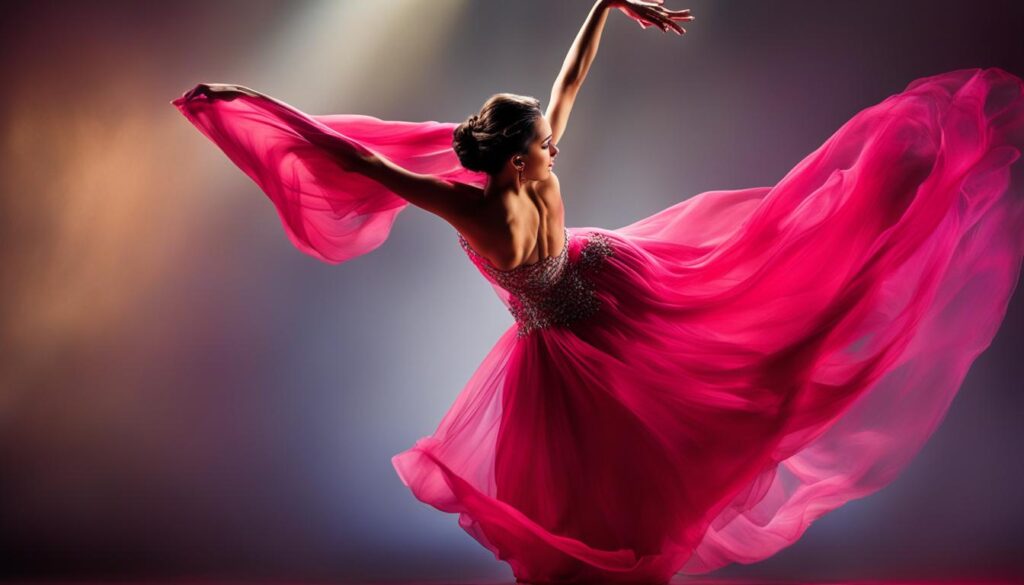

The Role of Dance in Performing Arts
The role of dance in performing arts goes beyond mere entertainment. It serves as a means of storytelling, cultural preservation, and social commentary. Dance has the ability to convey narratives, depict historical events, and highlight social issues. It can be a platform for expressing voices that may otherwise go unheard, shedding light on important topics and igniting conversations.
Furthermore, dance adds a sense of rhythm and movement to performances, elevating the overall artistic experience. It engages the senses and creates a visceral connection between performers and audiences. Dance can transport us to different worlds, evoke a range of emotions, and leave a lasting impact.
| Benefits of Dance in Performing Arts |
|---|
| Enhances storytelling |
| Preserves cultural heritage |
| Provides a platform for self-expression |
| Conveys complex ideas and emotions |
| Engages and captivates audiences |
The Multifaceted World of Theatre in Performing Arts
Theatre is a captivating and diverse art form that plays a vital role in the realm of performing arts. Combining elements of acting, singing, dance, music, puppetry, and more, theatre productions create immersive experiences that captivate audiences. It serves not only as a form of entertainment but also as a platform for social commentary, storytelling, and the exploration of the human condition.
In the world of performing arts, theatre holds significant cultural and societal importance. It has the power to reflect and critique society, provoke thought, and inspire change. Theatre can delve into historical events, address current social issues, and shed light on different perspectives. Through carefully crafted narratives and compelling performances, it engages audiences on intellectual, emotional, and visceral levels, fostering a deep connection between the performers and the viewers.
Theatre is not just a spectacle; it is a means to understand ourselves and the world around us. It serves as a mirror, reflecting back our joys, sorrows, hopes, and frustrations. It allows us to step into the shoes of others, encouraging empathy and expanding our understanding of diverse experiences. Theatre has the power to challenge our perceptions, broaden our horizons, and ignite conversations that can lead to positive social change.
Furthermore, theatre offers endless opportunities for artistic expression and creativity. From the grandeur of a Broadway musical to experimental avant-garde performances, theatre embraces a wide range of genres, styles, and techniques. It pushes boundaries, explores unconventional narratives, and redefines the boundaries of what is possible on stage. Theatre artists, including actors, directors, set designers, and costume designers, collaborate to bring visions to life and transport audiences to new and exciting worlds.
The Significance of Theatre in Performing Arts
Theatre holds a unique position within the realm of performing arts. It combines various art forms and disciplines and serves as a vibrant medium for artistic expression. Its significance lies not only in its ability to entertain but also in its capacity to explore complex themes, challenge societal norms, and inspire introspection. Theatre has the power to spark conversations, foster empathy, and generate a sense of unity and shared experience within a community.
Table: The Variety of Theatre Genres and Styles
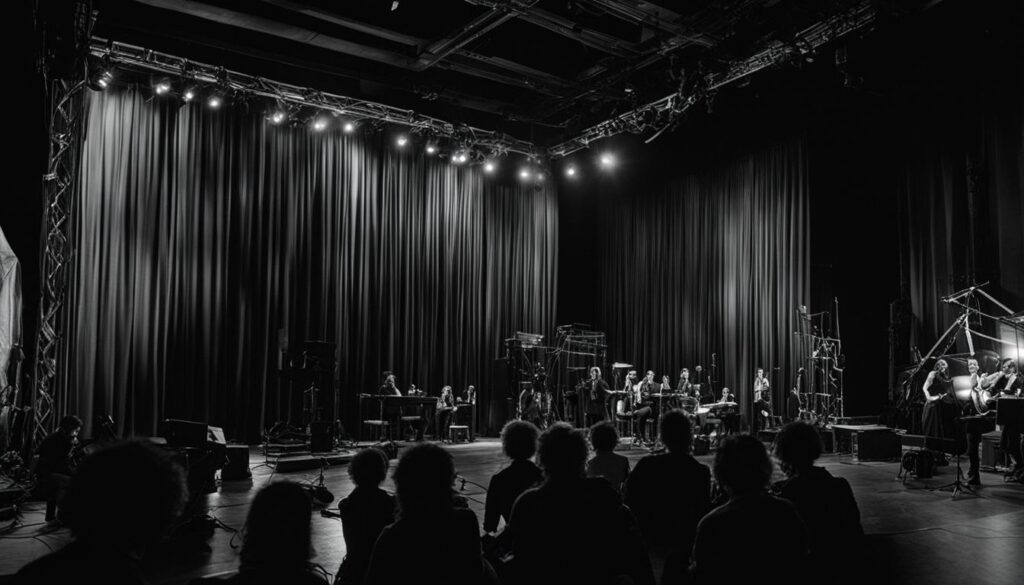

| Genre/Style | Description |
|---|---|
| Drama | Focuses on serious and intense themes, often featuring conflicts, emotional depth, and complex characters. |
| Comedy | Intended to amuse and entertain, typically featuring humorous situations, witty dialogue, and comedic timing. |
| Musical | Incorporates music, songs, and dance into the storytelling, enhancing emotions and adding an extra layer of expression. |
| Experimental | Explores unconventional theatrical techniques, narrative structures, and themes, pushing boundaries and challenging preconceived notions. |
| Puppetry | Uses puppets and marionettes to bring characters to life, creating a whimsical and imaginative theatrical experience. |
| Physical Theatre | Relies on movement, gesture, and physicality to convey ideas, emotions, and narratives, often without the use of spoken language. |
Theatre is a rich and multi-faceted art form within the realm of performing arts. Its ability to entertain, provoke thought, and foster connection makes it an essential part of our cultural landscape. By embracing and supporting theatre, we not only celebrate artistic expression but also uphold the values of creativity, empathy, and the power of storytelling.
The Benefits of Performing Arts Education
Engaging in performing arts education offers a wide range of benefits that positively impact individuals of all ages. From fostering creativity to enhancing communication skills, the importance of performing arts education cannot be understated.
One of the key advantages of performing arts education is its ability to nurture creativity. Through music, dance, and drama, individuals are encouraged to think outside the box, explore new ideas, and express themselves in unique ways. This creative thinking extends beyond the arts and can be applied to other areas of life, fostering innovation and problem-solving skills.
Furthermore, performing arts education plays a vital role in developing communication skills. Whether it’s through learning how to express emotions through dance or delivering lines in a play, individuals gain confidence in expressing themselves effectively. These communication skills are transferable to various aspects of life, including interpersonal relationships, professional settings, and public speaking engagements.
| Benefits of Performing Arts Education | Impact |
|---|---|
| Enhanced academic performance | Improved cognitive abilities, critical thinking, and problem-solving skills |
| Boosted self-confidence | Increased self-esteem and self-expression |
| Developed teamwork and collaboration skills | Effective communication, cooperation, and shared responsibility |
| Cultural appreciation | Greater understanding and respect for diverse traditions and perspectives |
| Emotional intelligence | Heightened empathy, self-awareness, and emotional expression |
Moreover, performing arts education has a significant impact on academic performance. Studies have shown that students involved in the performing arts demonstrate improved cognitive abilities, critical thinking, and problem-solving skills. The creative and collaborative nature of performing arts education fosters a love of learning and can enhance overall academic engagement.
In conclusion, the advantages of performing arts education are far-reaching. From fostering creativity and enhancing communication skills to boosting academic performance and promoting cultural appreciation, the impact of performing arts education is profound. By recognizing the importance of performing arts education and integrating it into the curriculum, individuals of all ages can experience the numerous benefits and unleash their full creative potential.
Conclusion
In conclusion, the performing arts encompass a rich tapestry of disciplines and forms of artistic expression. From music and dance to theatre and beyond, these art forms serve as a universal language that transcends cultural boundaries and reflects human creativity. They are an essential part of our intangible cultural heritage, preserving traditions and knowledge that would otherwise be lost.
Music holds a central place in the performing arts, adding richness, emotion, and cultural significance to performances. Dance, with its rhythmic movements and storytelling capabilities, adds visual beauty and dynamic energy. Theatre, a collaborative art form, engages audiences through a combination of acting, singing, dance, and more, allowing us to explore our emotions and experiences.
Engaging in performing arts education offers numerous benefits, fostering creativity, enhancing academic performance, and nurturing personal growth. By recognizing the importance of the performing arts and incorporating them into education, we create an environment that celebrates diversity, encourages self-expression, and inspires individuals of all ages and backgrounds.
Safeguarding and promoting performing arts traditions and techniques is crucial in preserving our cultural heritage and ensuring the continued development of these vibrant art forms. By embracing the performing arts, we foster creativity, inspire personal growth, and celebrate the joy of artistic expression.
FAQ
What are the different disciplines and forms of performing arts?
The performing arts encompass disciplines such as vocal and instrumental music, dance, theatre, pantomime, sung verse, and more.
What is the cultural significance of performing arts?
Performing arts are part of the intangible cultural heritage and reflect human creativity, preserving traditions and knowledge.
How does music contribute to performing arts?
Music is a universal form of expression that accompanies other art forms, adds richness to performances, and reflects social and economic dimensions.
What role does dance play in performing arts?
Dance involves rhythmic movements and gestures that express emotions, depict events, and contribute visual beauty and storytelling elements to performances.
How does theatre contribute to performing arts?
Theatre combines acting, singing, dance, music, and more to create performances that engage and entertain audiences. It provides a platform for storytelling, social commentary, and exploration of human experiences.
What are the benefits of performing arts education?
Engaging in performing arts education fosters creativity, imagination, emotional intelligence, improves academic performance, and empowers individuals in their careers. It contributes to personal growth and cultural appreciation.
